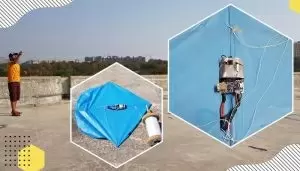'Kite camera' developed by IIIT-Hyderabad researchers
20-May-2021

Researchers at International Institute of Information Technology, Hyderabad (IIITH) have unveiled a unique kite camera that promises to be a cost-effective alternative to drones and existing Kite Assisted Photography (KAP).
The researchers from the Process, Architecture, and Technology Research in IoT (PATRIoT) designed a lightweight system that can be affixed to any ordinary kite for capturing images.
Unlike the present-day KAP structures that necessitate tethering a camera to a sturdy, specially tailored kite via a rig, the system called KiteCam is a kite with a sleek camera module attached to its spine.
Since a kite depends on wind for flying, the research team led by student Abhinav Navnit, under the guidance of Dr Aftab Hussain, first conducted an in-depth study of flight dynamics.
"The normal Indian 'patang' (kite) that you get has a weight of 10-15 gms, so in order to lift it and anything else mounted on that, one requires appropriate wind force. We figured out that normal wind conditions can carry something like 50 gms, of which 10 gms is the weight of the kite itself. So our entire system had to fit into approximately 40 gms," said De Hussain.
The system, which uses a camera, a processor and a battery, found its single biggest challenge in typical batteries being bulky and heavy. To counteract this, the team used two ultra-light and flexible lithium polymer batteries that weigh only 4.65 gms each. At 42 gms, the complete setup consisting of the batteries coupled with the camera and power management modules successfully weighed below the maximum limit required for lift-off.
In the first test flight itself, the KiteCam revealed its superiority over drones in terms of energy consumption by successfully flying for 35 minutes, during which a total of 4,356 images were taken. Terming this an unobtrusive way of surveillance, Dr. Hussain highlights the whirring noise and the size of drones that make them unlikely candidates for fact-finding missions in sensitive areas. Another plus that works in favour of the KiteCam is that since most of its surface area is non-electronic, it cannot be detected by radars.
According to the professor, the greatest advantage of the KiteCam is that it is battery-free. "Unlike a drone, the lift of the kite here is getting created through wind power and not battery power. It makes a huge difference between battery capacity and battery utilisation," says Dr Hussain. Based on the wind speed and camera settings, it was found that the current KiteCam design can perform surveillance for as long as six hours in a single flight.
Dr Hussain does admit that there are downsides of using a kite. "For one, you should have good kite flying skills. And unless you're looking to quickly scan a wide area, it's harder to precision control a kite for surveying a specifically marked out small area."
To advance the current capabilities of the KiteCam, plans are afoot to include optimising the shutter speed for better image stability and reducing the frames captured per second in order to save battery capacity. It can also be used as sensor for recording temperature, humidity, pollution for aerial environmental monitoring. - IANS
Former DGP Om Prakash Murder: Wife Under Investigation, Says Minister
Ricky Rai, Son of Underworld Don Muthappa Rai, Shot at Near Bengaluru
Khushbu Sundar’s X Account Hacked; Actress Seeks Urgent Help
ED Raids Bengaluru Dog Breeder Who Claimed to Own Rs 50 Crore Wolf-Dog
Raj Thackeray Slams Hindi Imposition in Maharashtra Schools, Warns of Statewide Protests








